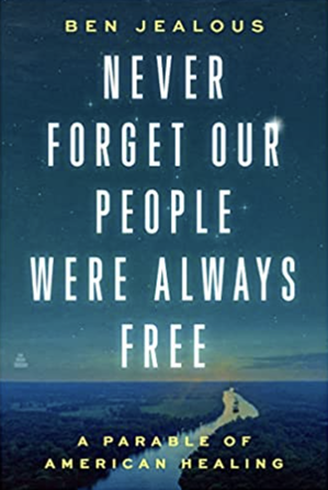Black History Month
Our February celebration of Black History Month offers rich opportunities for a look back and a look forward. We take a long view this month and recall the struggles and contributions of African-Americans from many walks of life throughout our nation's history. The stories speak to themes of respect, courage, justice, diligence, perseverance and hope. Many are excellent complements to specific Core Knowledge history units.
Featured Parent-Teacher Recommendation
|
Never Forget Our People Were Always Free. Benjamin Todd Jealous. Amistad, 2023.
Former President of the NAACP, Ben Jealous teaches in parables in this new book. Each chapter is a true story from his own life with a surprising and unexpected twist on race and community in America. "Denying the humanity of people of a darker hue" has been an all too common American tradition, Jealous asserts, stunting those dismissed and impeding growth toward our fullest ideals. But history and his own life experience incline Jealous to spotlight the times of collaborative effort to move beyond even systemic racism. His opening story "Who is Family?" contains a wonderful twist on those he and comedian Dave Chapelle rescued from distress after Hurricane Katrina devastated Baton Rouge. A book of healing and hope. |

The Tuskegee Airmen Story. Lynn Homan. Illustrated by Thomas Reilly. Pelican Publishing, 2002. Love of Country, Black History Month. (K-2)
Three children find their grandfather's old World War II memorabilia, and have lots of questions for their grandfather about his time in the war. It turns out that their grandfather served as a Tuskegee Airman: one of the brave African-American pilots who stepped up to defend their country in a time of segregation. For young children just starting to learn about World War II and Black History, this is an age-appropriate start, and a highlight is that it emphasizes the work of the African-American women among the Tuskegee Airmen as well. Accompanied by rich watercolor illustrations.
Three children find their grandfather's old World War II memorabilia, and have lots of questions for their grandfather about his time in the war. It turns out that their grandfather served as a Tuskegee Airman: one of the brave African-American pilots who stepped up to defend their country in a time of segregation. For young children just starting to learn about World War II and Black History, this is an age-appropriate start, and a highlight is that it emphasizes the work of the African-American women among the Tuskegee Airmen as well. Accompanied by rich watercolor illustrations.
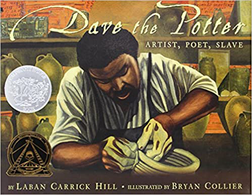
Dave the Potter: Artist, Poet, Slave. Laban Carrick Hill.
Illustrated by Bryan Collier. Little, Brown and Co, 2010. (K-3)
Diligence, Perseverance, Black History Month, Lives to Learn From
Sparse but poetic text tells the story of Dave, a potter, poet and slave on a nineteenth century South Carolina plantation. He finds beauty and meaning in the work of his hands. We follow him as he starts a pot from clay in the ground – mixing, pounding, shaping until finally, he inscribes the pot with a few lines of poetry he has composed. Dave was a prolific potter, whose works (many of them quite large and all over 175 years old) are in museums. This true story is beautifully illustrated in rich watercolors that bring to life Dave's physicality and the strength of his pots.
Illustrated by Bryan Collier. Little, Brown and Co, 2010. (K-3)
Diligence, Perseverance, Black History Month, Lives to Learn From
Sparse but poetic text tells the story of Dave, a potter, poet and slave on a nineteenth century South Carolina plantation. He finds beauty and meaning in the work of his hands. We follow him as he starts a pot from clay in the ground – mixing, pounding, shaping until finally, he inscribes the pot with a few lines of poetry he has composed. Dave was a prolific potter, whose works (many of them quite large and all over 175 years old) are in museums. This true story is beautifully illustrated in rich watercolors that bring to life Dave's physicality and the strength of his pots.
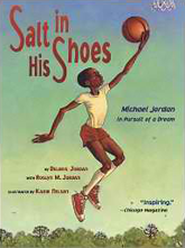
Salt in His Shoes. Michael Jordan in Pursuit of a Dream. Deloris Jordan. Illustrated by Kadir Nelson.Simon & Schuster, 2000. (K-3)Lives to Learn From
The true story of a little boy, who fears he will never be tall enough to play his favorite game (basketball) well. While waiting to grow, his parents advise him to hone his actual skills through patience, hardwork, prayer, and determination. The true grit of the young boy -- who becomes the legendary Michael Jordan -- does indeed pay off.
The true story of a little boy, who fears he will never be tall enough to play his favorite game (basketball) well. While waiting to grow, his parents advise him to hone his actual skills through patience, hardwork, prayer, and determination. The true grit of the young boy -- who becomes the legendary Michael Jordan -- does indeed pay off.
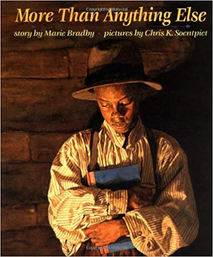
More Than Anything Else. Marie Bradby.
Illustrated by Chris K. Soentpiet. Orchard Books, 1995. (K-2) Hope
Young Booker T. Washington toils in the salt works with his father and brothers, but longs for the day when he’ll learn to read. He has a “hunger . . . in my head” and “even though my shoulders still ache and my legs are stained with salt, I . . . stare at the marks and try to imagine their song.” This is a beautifully and warmly illustrated story of a young boy whose hope is realized, and who, in turn, gave hope to generations of African Americans with his founding of Tuskegee Institute, one of the first historically black colleges.
Illustrated by Chris K. Soentpiet. Orchard Books, 1995. (K-2) Hope
Young Booker T. Washington toils in the salt works with his father and brothers, but longs for the day when he’ll learn to read. He has a “hunger . . . in my head” and “even though my shoulders still ache and my legs are stained with salt, I . . . stare at the marks and try to imagine their song.” This is a beautifully and warmly illustrated story of a young boy whose hope is realized, and who, in turn, gave hope to generations of African Americans with his founding of Tuskegee Institute, one of the first historically black colleges.

Sister Anne's Hands. Marybeth Lorbiecki
Illustrated by K. Wendy Popp. Dial Books, 1998. (K-2) Respect
“Welcome to the 2nd grade. I’m Sister Anne.” Set in the 1960s, this is a rich story of the only African-American nun in a small southern town. Sister Anne’s lessons to the 2nd graders entrusted to her care include the timeless classics of love, humor, and math, but mostly of human dignity, and the respect owed to each human being regardless of color. This is a moving book, with illustrations that combine realism with an ethereal, almost supernatural quality.
Illustrated by K. Wendy Popp. Dial Books, 1998. (K-2) Respect
“Welcome to the 2nd grade. I’m Sister Anne.” Set in the 1960s, this is a rich story of the only African-American nun in a small southern town. Sister Anne’s lessons to the 2nd graders entrusted to her care include the timeless classics of love, humor, and math, but mostly of human dignity, and the respect owed to each human being regardless of color. This is a moving book, with illustrations that combine realism with an ethereal, almost supernatural quality.
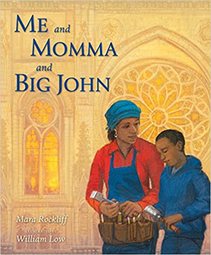
Me and Momma and Big John. Mara Rockliff. Illustrated by William Low.
Candlewick, 2012. (K-3) Diligence, Humility, Dignity of Labor
Based on a true story, this is a singular book with an unusual message. An African-American mother labors as a stone cutter for the Cathedral of St. John of the Divine (“Big John”) in New York City. It is hard physical labor, but also art, yet no one will know which stone she has cut. The latter profoundly annoys her children (the story is told through the eyes of her son) until they see her work in place at the luminous cathedral, and realize that it is part of something greater than one artist’s self-expression. A beautifully told, beautifully illustrated tale of diligence, the dignity of labor, community and humility.
Candlewick, 2012. (K-3) Diligence, Humility, Dignity of Labor
Based on a true story, this is a singular book with an unusual message. An African-American mother labors as a stone cutter for the Cathedral of St. John of the Divine (“Big John”) in New York City. It is hard physical labor, but also art, yet no one will know which stone she has cut. The latter profoundly annoys her children (the story is told through the eyes of her son) until they see her work in place at the luminous cathedral, and realize that it is part of something greater than one artist’s self-expression. A beautifully told, beautifully illustrated tale of diligence, the dignity of labor, community and humility.
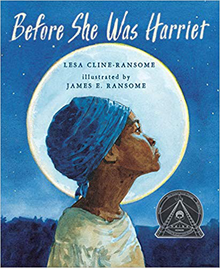
Before She Was Harriet.* Lesa Cline-Ransome.
Illustrated by James E. Ransome Holiday House, 2017.(K-3)
Courage, Service
A poetic review of the very full life of Harriet Tubman. Engrossing full-page watercolors draw you into the amazing accomplishments of Harriet’s life - suffragette, nurse, Union spy as well as conductor of the Underground Railroad. The text is sparse, but lyrical and will lead to many questions and discussion of Harriet’s courage and sense of purpose. Excellent with the second grade Core Knowledge unit on the Civil War. *Available on Epic!
Illustrated by James E. Ransome Holiday House, 2017.(K-3)
Courage, Service
A poetic review of the very full life of Harriet Tubman. Engrossing full-page watercolors draw you into the amazing accomplishments of Harriet’s life - suffragette, nurse, Union spy as well as conductor of the Underground Railroad. The text is sparse, but lyrical and will lead to many questions and discussion of Harriet’s courage and sense of purpose. Excellent with the second grade Core Knowledge unit on the Civil War. *Available on Epic!
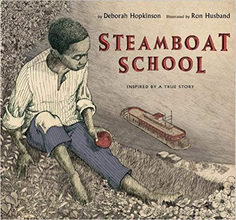
Steamboat School. Deborah Hopkinson. Illustrated by Ron Husband. Little, Brown Books for Young Readers, 2016.(K-2)
Courage, Perseverance, Justice, Black History Month
Set in Missouri 1847 and inspired by the life of freed slave Rev. John Berry Meachum. James and his sister Tassie attend class secretly in the basement of a church. Even though the children are not enslaved, schools in Missouri were not allowed to teach ‘Negroes or mulattoes’. When the basement school is discovered and closed, Rev. John is able to continue teaching the children on a steamboat he builds and anchors in the river, which is federal property, and not subject to Missouri law. Ron Husband’s evocative and detailed drawings show the life of the children and convey their deep desire to learn despite the obstacles. A marvelous book.
Courage, Perseverance, Justice, Black History Month
Set in Missouri 1847 and inspired by the life of freed slave Rev. John Berry Meachum. James and his sister Tassie attend class secretly in the basement of a church. Even though the children are not enslaved, schools in Missouri were not allowed to teach ‘Negroes or mulattoes’. When the basement school is discovered and closed, Rev. John is able to continue teaching the children on a steamboat he builds and anchors in the river, which is federal property, and not subject to Missouri law. Ron Husband’s evocative and detailed drawings show the life of the children and convey their deep desire to learn despite the obstacles. A marvelous book.
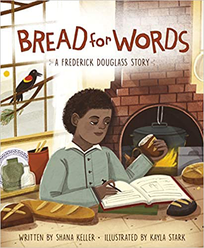
Bread for Words* Shana Keller. Illustrated by Kayla Stark. Sleeping Bear Press, 2020. (K-4) Black History Month, Perseverance.
Frederick Douglass, growing up as a slave, has many questions. Why is he a slave, why can’t he learn to read like the white boys? He learns that reading is the first step to being free. In this fictionalized first-person narrative, we see him devote himself to learning wherever he can, even trading bread for knowledge. His persistence in the pursuit of knowledge pays off. This is a fine portrayal of his early life. *Available on Epic!
Frederick Douglass, growing up as a slave, has many questions. Why is he a slave, why can’t he learn to read like the white boys? He learns that reading is the first step to being free. In this fictionalized first-person narrative, we see him devote himself to learning wherever he can, even trading bread for knowledge. His persistence in the pursuit of knowledge pays off. This is a fine portrayal of his early life. *Available on Epic!
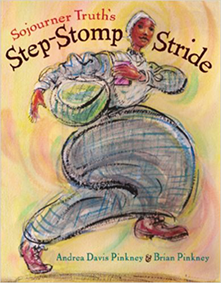
Sojourner Truth’s Step-Stomp Stride Andrea Pinkney.
Illustrated by Brian Pinkney. Hyperiond, 2009. (K-3)
An outstanding read-aloud, this true story of Belle Baumfree traces her youth in slavery, her escape to freedom, and her new life in freedom when she took the name Sojourner Truth, speaking out against slavery. The husband-wife team of Andrea and Brian Pinkney bring the spirit of this hopeful, fiery, and deeply religious woman to life, as she stepped, stomped, and strode her way across the United States to advocate for freedom and women's rights.
Illustrated by Brian Pinkney. Hyperiond, 2009. (K-3)
An outstanding read-aloud, this true story of Belle Baumfree traces her youth in slavery, her escape to freedom, and her new life in freedom when she took the name Sojourner Truth, speaking out against slavery. The husband-wife team of Andrea and Brian Pinkney bring the spirit of this hopeful, fiery, and deeply religious woman to life, as she stepped, stomped, and strode her way across the United States to advocate for freedom and women's rights.
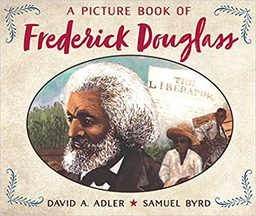
A Picture Book of Frederick Douglass.* David Adler.
Illustrated by Samuel Byrd. Holiday, 1993. (2-4)
A detailed recounting of the astonishing life of Frederick Douglass. Largely self-taught, enslaved Frederick found encouragement in the Bible, and did not accept enslavement as his lot for life. He witnessed and endured its horrors first hand (flogging of his aunt and himself), escaped to the north, wrote with passion of his experience, became the first African-American publisher and most influential spokesmen for civil rights in the antebellum period. The book covers Douglass's work in the Civil War to assemble a black regiment and his lifelong support for women's rights. *Available on Epic!
Illustrated by Samuel Byrd. Holiday, 1993. (2-4)
A detailed recounting of the astonishing life of Frederick Douglass. Largely self-taught, enslaved Frederick found encouragement in the Bible, and did not accept enslavement as his lot for life. He witnessed and endured its horrors first hand (flogging of his aunt and himself), escaped to the north, wrote with passion of his experience, became the first African-American publisher and most influential spokesmen for civil rights in the antebellum period. The book covers Douglass's work in the Civil War to assemble a black regiment and his lifelong support for women's rights. *Available on Epic!
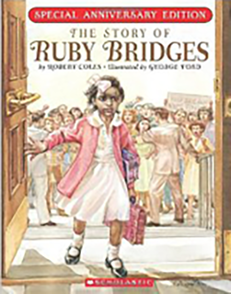
The Story of Ruby Bridges. Robert Coles.
Illustrated by George Ford. Scholastic, 2010.
(K-4)Forgiveness, Compassion, Faith, Courage, Justice
This extraordinary picture book is a touching, age-appropriate retelling of the first black child to integrate Louisiana’s segregated schools. In November 1960, six-year-old Ruby Bridges was escorted by federal marshals to her new school, and a jeering crowd outside booed, spat, and threw things. Ruby’s family’s faith, the child’s courage and her prayer that “Please God, try to forgive these people. Because even if they say those bad things. They don’t know what they are doing” are all remarkable. This version was authored by Harvard child psychiatrist Robert Coles (The Moral Lives of Children), and is in its anniversary reprint edition. A classic.
Illustrated by George Ford. Scholastic, 2010.
(K-4)Forgiveness, Compassion, Faith, Courage, Justice
This extraordinary picture book is a touching, age-appropriate retelling of the first black child to integrate Louisiana’s segregated schools. In November 1960, six-year-old Ruby Bridges was escorted by federal marshals to her new school, and a jeering crowd outside booed, spat, and threw things. Ruby’s family’s faith, the child’s courage and her prayer that “Please God, try to forgive these people. Because even if they say those bad things. They don’t know what they are doing” are all remarkable. This version was authored by Harvard child psychiatrist Robert Coles (The Moral Lives of Children), and is in its anniversary reprint edition. A classic.
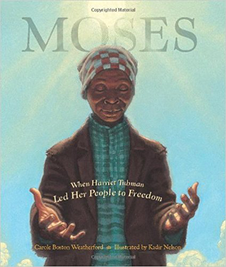
Moses:When Harriet Tubman Led her People to Freedom
Carole Boston Weatherford.
Illustrated by Kadir Nelson. Hyperion, 2006. (Justice, K-4)
A model of faith and courage, Harriet Tubman gazes at the night sky and hears the voice of the Lord, calling her to freedom. Confident of God's faithfulness, she escapes the harsh reality of slavery, and dedicates herself to freeing others. She became for slaves their "Moses," leading them out of oppression on the Underground Railroad. Stark, dramatic, and beautiful illustrations trace this humble woman's journey.
Carole Boston Weatherford.
Illustrated by Kadir Nelson. Hyperion, 2006. (Justice, K-4)
A model of faith and courage, Harriet Tubman gazes at the night sky and hears the voice of the Lord, calling her to freedom. Confident of God's faithfulness, she escapes the harsh reality of slavery, and dedicates herself to freeing others. She became for slaves their "Moses," leading them out of oppression on the Underground Railroad. Stark, dramatic, and beautiful illustrations trace this humble woman's journey.
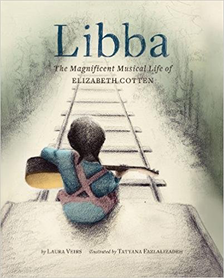
Libba: The Magnificent Musical Life of Elizabeth Cotton. Laura Veirs.
Illustrated by Tatyana Fazlalizadeh. Chronicle Books, 2018.
(K-4) Perseverance
As an African-American child in the early 1900s, Elizabeth Cotton heard music on the wind, in the woods, and on the train tracks. She taught herself to play her brother’s guitar, and that was tricky because she was left-handed and he was not. She learned to play it upside down and backwards, wrote the song “Freight Train” by the time she was eleven, and developed a repertoire. A career in music wasn’t an option for girls of her background, though. So for years, Libba worked as a maid and housekeeper, became a mother and grandmother, and kept the music in her heart – till she started to work for the Seeger family (of folk music fame). They recognized her enormous talent, supported her dream deferred, and in her fifties, Libba began to perform and receive national acclaim. This a lyrically written and softly illustrated book that speaks to all who have a passion they do not abandon – and especially to late bloomers.
Illustrated by Tatyana Fazlalizadeh. Chronicle Books, 2018.
(K-4) Perseverance
As an African-American child in the early 1900s, Elizabeth Cotton heard music on the wind, in the woods, and on the train tracks. She taught herself to play her brother’s guitar, and that was tricky because she was left-handed and he was not. She learned to play it upside down and backwards, wrote the song “Freight Train” by the time she was eleven, and developed a repertoire. A career in music wasn’t an option for girls of her background, though. So for years, Libba worked as a maid and housekeeper, became a mother and grandmother, and kept the music in her heart – till she started to work for the Seeger family (of folk music fame). They recognized her enormous talent, supported her dream deferred, and in her fifties, Libba began to perform and receive national acclaim. This a lyrically written and softly illustrated book that speaks to all who have a passion they do not abandon – and especially to late bloomers.

Ron’s Big Mission. Rose Blue and Corinne Naden. Illustrated by Don Tate. (1-3) Courage, Justice, Black History Month.
Ron, a nine-year-old boy in South Carolina in the 1950s, heads out one day with a very important mission. He wants to check out library books about aviation —but only white people are allowed to check books out of the library. He takes a stand (literally on a counter) and says out loud what all the adults want to deny: “The rules are not fair.” The police are called, but in the end Ron gets a library card, and from then on, everyone can. This story is based on the real life of Ron McNair, who would go on to graduate as high school valedictorian, get a PhD in physics from MIT, and become an astronaut on the space shuttle Challenger. A crater on the Moon is named in his honor. Lovely, childlike illustrations.
Ron, a nine-year-old boy in South Carolina in the 1950s, heads out one day with a very important mission. He wants to check out library books about aviation —but only white people are allowed to check books out of the library. He takes a stand (literally on a counter) and says out loud what all the adults want to deny: “The rules are not fair.” The police are called, but in the end Ron gets a library card, and from then on, everyone can. This story is based on the real life of Ron McNair, who would go on to graduate as high school valedictorian, get a PhD in physics from MIT, and become an astronaut on the space shuttle Challenger. A crater on the Moon is named in his honor. Lovely, childlike illustrations.
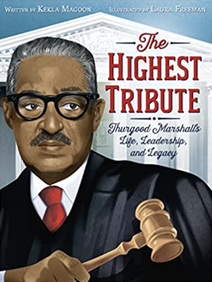
The Highest Tribute. Thurgood Marshall's Life, Leadership and Legacy. Kekla Magoon. Illustrated by Laura Freeman. Quill Tree Books, 2021 (1-3) Justice, Perseverance
The fabulous illustrations draw younger readers into Thurgood Marshall's life and legacy as “Mr. Civil Rights.” A concise and motivating biography of the boy-turned-man who decided if something in the world needed changing, he'd change it. His legacy to a more just society was to help make segregation and discrimination unlawful. (See our February Hero recommendations for more suggestions.)
The fabulous illustrations draw younger readers into Thurgood Marshall's life and legacy as “Mr. Civil Rights.” A concise and motivating biography of the boy-turned-man who decided if something in the world needed changing, he'd change it. His legacy to a more just society was to help make segregation and discrimination unlawful. (See our February Hero recommendations for more suggestions.)
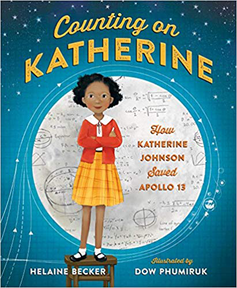
Counting on Katherine: How Katherine Johnson Saved Apollo 13.*
Helaine Becker. Tiemdow Phumiruk. Henry Holt & Co. 2018. (1-4) Diligence, Perseverance, Lives to Learn From.
Katherine was always counting - math made sense to her. She loved learning about it and was frustrated when it came time for her to go to high school because her town’s high school wouldn’t admit black students. Her father worked night and day to earn enough to move the family to a town with a black high school. Katherine became a teacher, but still dreamed of solving bigger math problems. Finally, NASA advertised for a “computer” – a woman to do basic math calculations needed for space flight. Katherine's skill landed her the job, and now she was in a place where she could make a difference. She worked her way up from basic computing to planning the path of the Mercury space missions. Her vision and talent as a mathematician made her a great asset to the space program, and key to the Apollo 13 return.*Available on Epic!
Helaine Becker. Tiemdow Phumiruk. Henry Holt & Co. 2018. (1-4) Diligence, Perseverance, Lives to Learn From.
Katherine was always counting - math made sense to her. She loved learning about it and was frustrated when it came time for her to go to high school because her town’s high school wouldn’t admit black students. Her father worked night and day to earn enough to move the family to a town with a black high school. Katherine became a teacher, but still dreamed of solving bigger math problems. Finally, NASA advertised for a “computer” – a woman to do basic math calculations needed for space flight. Katherine's skill landed her the job, and now she was in a place where she could make a difference. She worked her way up from basic computing to planning the path of the Mercury space missions. Her vision and talent as a mathematician made her a great asset to the space program, and key to the Apollo 13 return.*Available on Epic!
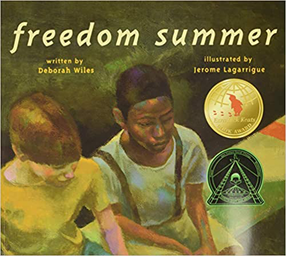
Freedom Summer. Deborah Wiles. Illustrated by Jerome Lagarrique. Aladdin, 2005.(K-3) Friendship, Justice, Black History Month
John Henry and Joe are best friends. They love to play together in the long days of summer, swimming in the creek. They would like to swim in the town pool but that isn’t possible because Joe is white, and John Henry is black. Then in 1964, a law is passed forbidding segregation, and the two boys race to the pool only to find that it is being filled with concrete, rather than allow blacks and whites to swim together. It will take more than a law for people to let go of prejudice, but Joe and John Henry are showing the way.
John Henry and Joe are best friends. They love to play together in the long days of summer, swimming in the creek. They would like to swim in the town pool but that isn’t possible because Joe is white, and John Henry is black. Then in 1964, a law is passed forbidding segregation, and the two boys race to the pool only to find that it is being filled with concrete, rather than allow blacks and whites to swim together. It will take more than a law for people to let go of prejudice, but Joe and John Henry are showing the way.
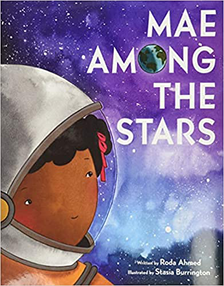
Mae Among the Stars. Roda Ahmed. Illustrated by Stasia Burrington. Harper Collins, 2018. (K-3) Perseverance, Lives to Learn From, Black History Month
The inspirational story of the first African-American woman in space. Mae Jemison dreamed of her life among the stars since childhood: dancing among them, floating and gliding by them, looking down at Earth. She shared her dream of becoming an astronaut with her parents, friends and teachers--some of whom urged her to keep her feet on the ground! They tried to dissuade her. But Mae, "the dreamer," worked hard towards her goal, kept dreaming big, and realized her goal. Energetic artwork portrays Mae’s dream beautifully.
The inspirational story of the first African-American woman in space. Mae Jemison dreamed of her life among the stars since childhood: dancing among them, floating and gliding by them, looking down at Earth. She shared her dream of becoming an astronaut with her parents, friends and teachers--some of whom urged her to keep her feet on the ground! They tried to dissuade her. But Mae, "the dreamer," worked hard towards her goal, kept dreaming big, and realized her goal. Energetic artwork portrays Mae’s dream beautifully.
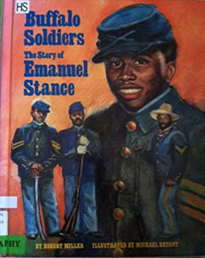
Buffalo Soldiers. The Story of Emmanuel Stance. Robert Miller
Illustrated by Michael Bryant. Silver Burdett Press, 1992. (2-5)
Emmanuel Stance was the first African-American to receive the Congressional Medal of Honor (1870). This picture book tells the story of the first all-black infantry regiments formed after the Civil War and Stance’s leadership and courage in confronting Kiowa and Comanche raiding parties.
Illustrated by Michael Bryant. Silver Burdett Press, 1992. (2-5)
Emmanuel Stance was the first African-American to receive the Congressional Medal of Honor (1870). This picture book tells the story of the first all-black infantry regiments formed after the Civil War and Stance’s leadership and courage in confronting Kiowa and Comanche raiding parties.

Keep On! The Story of Matthew Henson: Co-Discoverer of the North Pole.* Deborah Hopkinson. Illustrated by Stephen Alcon. Peachtree Publishing, 2015.(1-5) Perseverance, Black History Month
Fantastic, swirling images draw the young reader into this story of perseverance and courage. Matthew Henson, born just after the Civil War, longed for adventure. At 13 he signed on as a cabin boy aboard a ship that went around the world for the next 5 years. The captain taught him navigation and math. Soon after Matthew met Robert Peary, who invited him to go to the North Pole with his expedition in 1909. Matthew was delighted to meet the Inuit people who would help them reach the Pole. It was an arduous, frigid journey, but they finally accomplished their goal. The lovely book is peppered with quotations from Henson's own writings. *Available on Epic!
Fantastic, swirling images draw the young reader into this story of perseverance and courage. Matthew Henson, born just after the Civil War, longed for adventure. At 13 he signed on as a cabin boy aboard a ship that went around the world for the next 5 years. The captain taught him navigation and math. Soon after Matthew met Robert Peary, who invited him to go to the North Pole with his expedition in 1909. Matthew was delighted to meet the Inuit people who would help them reach the Pole. It was an arduous, frigid journey, but they finally accomplished their goal. The lovely book is peppered with quotations from Henson's own writings. *Available on Epic!
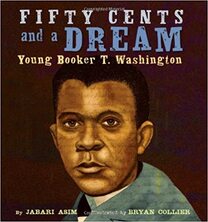
Fifty Cents and a Dream: Young Booker T. Washington. Jabari Asim. Illustrated by Bryan Collier. Little Brown, 2012. (1-4) Justice, Diligence, Black History
Lyrical and inspiring presentation of the against-all-odds childhood and coming-of-age of Booker T. Washington, one of America's foremost civil rights leaders. The beautifully illustrated book recounts his birth into slavery, longing to read as he walked his master's daughter to school (holding her books), his post-emancipation work in a salt furnace, coal mine, and as a servant before saving enough money to attempt the journey to Hampton Institute, where he could begin his formal education.
Lyrical and inspiring presentation of the against-all-odds childhood and coming-of-age of Booker T. Washington, one of America's foremost civil rights leaders. The beautifully illustrated book recounts his birth into slavery, longing to read as he walked his master's daughter to school (holding her books), his post-emancipation work in a salt furnace, coal mine, and as a servant before saving enough money to attempt the journey to Hampton Institute, where he could begin his formal education.
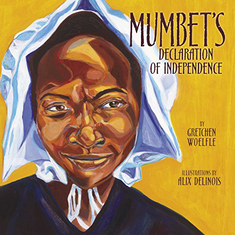
Mumbet’s Declaration of Independence.* Gretchen Woelfle. Illustrated by Alix Delinois. Carolrhoda Books, 2014.(1-4) Hope, Perseverance
Mumbet grows up as a slave to the Ashley family of Massachusetts in the late eighteenth century. She did not mind hard work, but she did mind not being free. One night at a town hall meeting, Mumbet hears people discussing the Constitution for the state, which proclaims that “all men are born equal and free." She takes this to heart and hires a lawyer to sue for her freedom. She is not only successful winning her freedom, but also having slavery declared unconstitutional in Massachusetts! Powerful, bright acrylic illustrations highlight Mumbet’s strength and hope in justice in her future.*Available on Epic!
Mumbet grows up as a slave to the Ashley family of Massachusetts in the late eighteenth century. She did not mind hard work, but she did mind not being free. One night at a town hall meeting, Mumbet hears people discussing the Constitution for the state, which proclaims that “all men are born equal and free." She takes this to heart and hires a lawyer to sue for her freedom. She is not only successful winning her freedom, but also having slavery declared unconstitutional in Massachusetts! Powerful, bright acrylic illustrations highlight Mumbet’s strength and hope in justice in her future.*Available on Epic!

Between the Lines: How Ernie Barnes Went From the Football Field to the Art Gallery. Sandra Neil Wallace. Illustrated by Bryan Collier. Simon & Schuster, 2018. (1-4) Perseverance, Imagination, Black History Month.
Bryan Collier brings his considerable talents to the true story of a young boy with a passion for painting and drawing. He would grow up to play professional football but he never lost his love of art, and resolved to follow his dream after his retirement from the NFL. At a time when African-American art was not seen as cutting edge, Barnes lived a life bringing together football and art—beginning with a painting of football players waiting on the bench. After his successful football career, he was offered a football player’s salary by the owner of the New York Jets to create his dynamic sports paintings. His paintings, characterized by elongated limbs and lithe movement, are sought after today.
Bryan Collier brings his considerable talents to the true story of a young boy with a passion for painting and drawing. He would grow up to play professional football but he never lost his love of art, and resolved to follow his dream after his retirement from the NFL. At a time when African-American art was not seen as cutting edge, Barnes lived a life bringing together football and art—beginning with a painting of football players waiting on the bench. After his successful football career, he was offered a football player’s salary by the owner of the New York Jets to create his dynamic sports paintings. His paintings, characterized by elongated limbs and lithe movement, are sought after today.
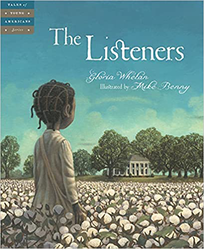
The Listeners.* Gloria Whelan. Illustrated by Mike Benny. Sleeping Bear Press, 2009 (1-4) Black History. *Available on Epic!
Ella May is a young slave who lives on a cotton plantation and the year is 1860. Ella's job during the day is to pick cotton. At night, she and her friends are tasked with listening at the windows of the big house and bringing the good news and bad news back to the slave families.
Ella May is a young slave who lives on a cotton plantation and the year is 1860. Ella's job during the day is to pick cotton. At night, she and her friends are tasked with listening at the windows of the big house and bringing the good news and bad news back to the slave families.
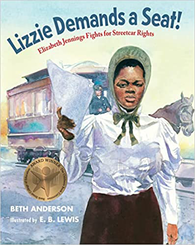
Lizzie Demands a Seat. Beth Anderson. Illustrated by E. B.Lewis. Calkins Creek, 2020. (3-6)Justice, Perseverance, Women's History Month, Black History Month
Rosa Parks is a famous twentieth century name, but it was Elizabeth Jennings who first sued for racial justice in transportation in 1854, when she was denied a seat on a New York City streetcar (though New York was a free state and she was a free woman). Represented by future U.S. President Chester Arthur, Lizzie won her case, the first for equal rights in public transportation in U.S. history. The verdict reveals the triumph of justice over prejudice in New York even before the Civil War. "The arc of history bends toward justice," contended Martin Luther King, Jr., and this story bears out his intuition.
Rosa Parks is a famous twentieth century name, but it was Elizabeth Jennings who first sued for racial justice in transportation in 1854, when she was denied a seat on a New York City streetcar (though New York was a free state and she was a free woman). Represented by future U.S. President Chester Arthur, Lizzie won her case, the first for equal rights in public transportation in U.S. history. The verdict reveals the triumph of justice over prejudice in New York even before the Civil War. "The arc of history bends toward justice," contended Martin Luther King, Jr., and this story bears out his intuition.
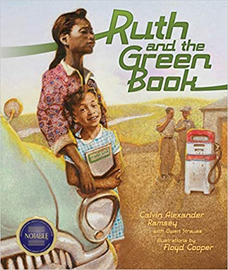
Ruth and the Green Book.* Calvin Alexander Ramsey.
Illustrated by Floyd Cooper. Carolrhoda Books, 2010. (2-6) Respect, Justice, Black History
This beautifully illustrated picture book set in the 1950s describes the journey of an African-American through the eyes of seven- or eight-year-old Ruth. The family travels from their home in Chicago to visit her father's family in Alabama. Ruth's father has bought a beautiful sea-mist green Buick, and as they travel south, service station owners are happy to sell them gas, but some won't let them use the ("white only") restrooms and some restaurant and hotel owners won't accommodate them. "Daddy was upset about something called Jim Crow laws," and Ruth is hurt and puzzled. A friendly gas station attendant hands them "The Negro Motorist's Green Book," which alerts them to places along the way where they will be warmly received. Many are now familiar with "The Green Book" from the recent movie, but this fictional children's book brings the story to life for children. They empathize with the injustice and indignities faced by many African Americans. A poignant, empathetic book that ends happily, but shines a light on the contours of mid-twentieth century racism, which sparked the Civil Rights movement led by Martin Luther King, Jr. *Available on Epic!
Illustrated by Floyd Cooper. Carolrhoda Books, 2010. (2-6) Respect, Justice, Black History
This beautifully illustrated picture book set in the 1950s describes the journey of an African-American through the eyes of seven- or eight-year-old Ruth. The family travels from their home in Chicago to visit her father's family in Alabama. Ruth's father has bought a beautiful sea-mist green Buick, and as they travel south, service station owners are happy to sell them gas, but some won't let them use the ("white only") restrooms and some restaurant and hotel owners won't accommodate them. "Daddy was upset about something called Jim Crow laws," and Ruth is hurt and puzzled. A friendly gas station attendant hands them "The Negro Motorist's Green Book," which alerts them to places along the way where they will be warmly received. Many are now familiar with "The Green Book" from the recent movie, but this fictional children's book brings the story to life for children. They empathize with the injustice and indignities faced by many African Americans. A poignant, empathetic book that ends happily, but shines a light on the contours of mid-twentieth century racism, which sparked the Civil Rights movement led by Martin Luther King, Jr. *Available on Epic!
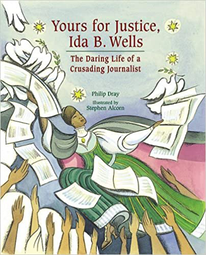
Yours For Justice, Ida B. Wells. The Daring Life of a Crusading Journalist* Philip Dray. Illustrated by Stephen Alcorn. Peachtree Publishing, 2008. (3-6) Justice, Hope, Compassion, Lives to Learn From
Born into slavery but freed by the Emancipation Proclamation, Ida B. Wells was a force of nature. She loved to read, and reading the newspaper to her father opened her eyes to the world beyond her small town. When she lost both her parents and her brother to an epidemic, she took charge of her six siblings and taught school to support them. She never stopped learning, and she felt the need to start writing about the injustices daily. She became a leading journalist, writing about many issues, but when one of her friends was lynched, Ida became the voice for justice for him and many others like him. Intriguing illustrations bring Ida’s story to life. Afterword and bibliography make this a great tribute to a Life to Learn From. *Available on Epic!
Born into slavery but freed by the Emancipation Proclamation, Ida B. Wells was a force of nature. She loved to read, and reading the newspaper to her father opened her eyes to the world beyond her small town. When she lost both her parents and her brother to an epidemic, she took charge of her six siblings and taught school to support them. She never stopped learning, and she felt the need to start writing about the injustices daily. She became a leading journalist, writing about many issues, but when one of her friends was lynched, Ida became the voice for justice for him and many others like him. Intriguing illustrations bring Ida’s story to life. Afterword and bibliography make this a great tribute to a Life to Learn From. *Available on Epic!
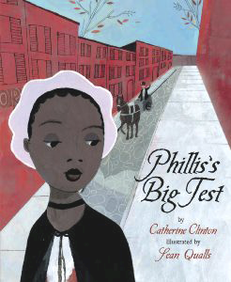
Phillis’s Big Test.* Catherine Clinton. Illustrated by Sean Qualls.
HMH Books for Young Readers, 2008. (2-3) Women’s History Month,
Black History Month, Courage, Diligence
Phillis Wheatly was brought to America as a slave when she was seven-years-old. She learned to read and write with the master’s children. She began writing poetry at a young age, and had a gift for it. When she took her poems to be printed in a single volume, the printer refused because he couldn’t believe she had written them. She was asked to appear before a panel of eighteen men, including the Governor and several ministers and poets, to test that she was the author. She passed easily and became the first black woman poet to be published in 1773, and became a free woman shortly thereafter.
HMH Books for Young Readers, 2008. (2-3) Women’s History Month,
Black History Month, Courage, Diligence
Phillis Wheatly was brought to America as a slave when she was seven-years-old. She learned to read and write with the master’s children. She began writing poetry at a young age, and had a gift for it. When she took her poems to be printed in a single volume, the printer refused because he couldn’t believe she had written them. She was asked to appear before a panel of eighteen men, including the Governor and several ministers and poets, to test that she was the author. She passed easily and became the first black woman poet to be published in 1773, and became a free woman shortly thereafter.

Night Running: How James Escaped with the Help of His Faithful Dog. Elisa Carbone. Illustrated by Earl B. Lewis. Knopf Books for Young Readers, 2008. (2-4) Courage, Loyalty, Love of Country, Black History Month.
Based on a true story and with powerful, impressionist style illustrations, this book tells the story of young James and his journey to escape slavery. He strictly instructs his dog Zeus not to come along, but Zeus disregards his master's instructions, and his loyalty ends up being pivotal in James' journey to freedom. In February, our month for Love of Country but also Black History Month, it's important for children to remember the times when we have not lived up to our ideals and the Americans who began their lives here as enslaved people. Content makes this a 2-4 book.
Based on a true story and with powerful, impressionist style illustrations, this book tells the story of young James and his journey to escape slavery. He strictly instructs his dog Zeus not to come along, but Zeus disregards his master's instructions, and his loyalty ends up being pivotal in James' journey to freedom. In February, our month for Love of Country but also Black History Month, it's important for children to remember the times when we have not lived up to our ideals and the Americans who began their lives here as enslaved people. Content makes this a 2-4 book.
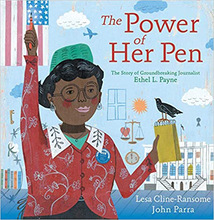
The Power of Her Pen. The Story of Groundbreaking Journalist Ethel L. Payne. Lesa Cline-Ransome. Illustrated by John Parra. Simon and Schuster, 2020. (2-5) Lives to Learn From, Women’s History Month, Black History Month
Ethel Payne loved to hear stories and she loved to tell stories. The granddaughter of slaves, she was educated in Depression Era Chicago, and encountered both racism and opportunity. In (her newly integrated) high school she wanted to work on the school paper, but was turned down because she was black. However, the paper did print her stories. After college she pursued journalism, and embarked on a career that took her from Chicago to Tokyo to the White House. She wrote stories about the black servicemen in Tokyo after World War II. This work inspired her to be an advocate for civil rights. When she returned to Chicago, her voice was heard through her pen, as she spoke out about housing, jobs and health care. She was sent to Washington and gained a coveted White House press pass – one of only 3 black journalists at the time. She asked questions of Presidents Eisenhower, Kennedy, Johnson, Nixon and Carter, earning the title “First Lady of the Black Press." Lively illustrations. The historical background and political context make this an older child's picture book.
Ethel Payne loved to hear stories and she loved to tell stories. The granddaughter of slaves, she was educated in Depression Era Chicago, and encountered both racism and opportunity. In (her newly integrated) high school she wanted to work on the school paper, but was turned down because she was black. However, the paper did print her stories. After college she pursued journalism, and embarked on a career that took her from Chicago to Tokyo to the White House. She wrote stories about the black servicemen in Tokyo after World War II. This work inspired her to be an advocate for civil rights. When she returned to Chicago, her voice was heard through her pen, as she spoke out about housing, jobs and health care. She was sent to Washington and gained a coveted White House press pass – one of only 3 black journalists at the time. She asked questions of Presidents Eisenhower, Kennedy, Johnson, Nixon and Carter, earning the title “First Lady of the Black Press." Lively illustrations. The historical background and political context make this an older child's picture book.
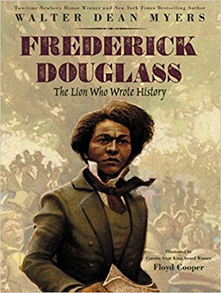
Frederick Douglass: The Lion Who Wrote History. Walter Dean Myers. Illustrated by Floyd Cooper. Harper Collins, 2017. (2-6)Love of our Country's Ideals
A rich picture book biography of Frederick Douglass, the great orator, writer, newspaper publisher, and advocate for the abolition of slavery. Born a slave in Maryland in 1818, Douglass taught himself to read, and later wrote: “Once you learn to read, you will be forever free.” When he escaped slavery, he became a leading voice for abolitionism, writing his own autobiography and publishing an abolitionist newspaper. In the Civil War, Douglass pressed Lincoln for emancipation and urged that blacks be allowed to fight for the cause. There is a curious omission in this book: it does not mention that three of Douglass’s own sons fought in the 54th Massachusetts Infantry. Nonetheless, this is a fine book. Lush illustrations trace Douglass’s early life, his struggle for an education and freedom, and his adult quest to change the United States for the better, seeking its ideals of equality and freedom for all. Appropriate for children second grade and older. This is not a younger child’s book, despite publisher recommendation.
A rich picture book biography of Frederick Douglass, the great orator, writer, newspaper publisher, and advocate for the abolition of slavery. Born a slave in Maryland in 1818, Douglass taught himself to read, and later wrote: “Once you learn to read, you will be forever free.” When he escaped slavery, he became a leading voice for abolitionism, writing his own autobiography and publishing an abolitionist newspaper. In the Civil War, Douglass pressed Lincoln for emancipation and urged that blacks be allowed to fight for the cause. There is a curious omission in this book: it does not mention that three of Douglass’s own sons fought in the 54th Massachusetts Infantry. Nonetheless, this is a fine book. Lush illustrations trace Douglass’s early life, his struggle for an education and freedom, and his adult quest to change the United States for the better, seeking its ideals of equality and freedom for all. Appropriate for children second grade and older. This is not a younger child’s book, despite publisher recommendation.

The Nutcracker in Harlem.* T.E. McMorrow. Illustrated by James Ransome. Harper Collins, 2017. (2-4) Holidays, Wonder, Black History Month
McMorrow has marvelously recast the Nutcracker story in Harlem of the 1920s. An African American family steeped in jazz gathers on Christmas Eve to sing and celebrate. Young Marie is given a nutcracker. The rest unfolds in wondrous joy. The watercolor illustrations bring the Harlem Renaissance to life, and deliver a new twist on classic. *Available on Epic!
McMorrow has marvelously recast the Nutcracker story in Harlem of the 1920s. An African American family steeped in jazz gathers on Christmas Eve to sing and celebrate. Young Marie is given a nutcracker. The rest unfolds in wondrous joy. The watercolor illustrations bring the Harlem Renaissance to life, and deliver a new twist on classic. *Available on Epic!
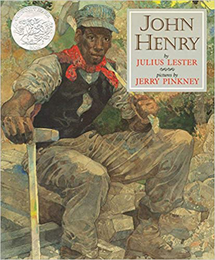
John Henry. Julius Lester
Illustrated by Jerry Pinkney. Dial Books, 1994. (2-4)Perseverance
A humorous, “tall-tale” version of the African-American folk hero of the railroad age, who “died with a hammer in his hand.” John Henry’s determination and will to work come shining through. Lester’s closing: “It’s not the dying, but how you did the living that counts.”
Illustrated by Jerry Pinkney. Dial Books, 1994. (2-4)Perseverance
A humorous, “tall-tale” version of the African-American folk hero of the railroad age, who “died with a hammer in his hand.” John Henry’s determination and will to work come shining through. Lester’s closing: “It’s not the dying, but how you did the living that counts.”
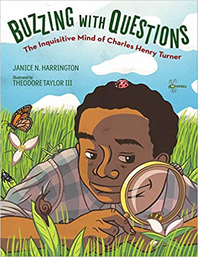
Buzzing with Questions: The Inquisitive Mind of Charles Henry Turner. Janice N. Harrington. Illustrated by Theodore Taylor III. Calkins Creek, 2019. 2-6. Wonder, Perseverance, Lives to Learn From, Black History.
An indefatigable entomologist? YES. Charles Henry Turner was that and more. This lively picture book reveals the insatiable curiosity and persistence of a scientist who wanted to get to the bottom of certain mysteries that bugged him: for example, could spiders think? Turner asked that question in 1874 as a child of seven. He set up experiments in his lab at home to draw conclusions, and despite obstacles that confronted him because of his race, went on to become a world expert on ants, bees, arachnids and more. Lively writing and sharp, colorful digital illustrations make the book sing.
An indefatigable entomologist? YES. Charles Henry Turner was that and more. This lively picture book reveals the insatiable curiosity and persistence of a scientist who wanted to get to the bottom of certain mysteries that bugged him: for example, could spiders think? Turner asked that question in 1874 as a child of seven. He set up experiments in his lab at home to draw conclusions, and despite obstacles that confronted him because of his race, went on to become a world expert on ants, bees, arachnids and more. Lively writing and sharp, colorful digital illustrations make the book sing.
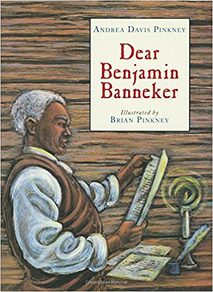
Dear Benjamin Banneker .* Andrea Davis Pinkney.
Illustrated by Brian Pinkney. Hougton Mifflin Harcourt, 2015. (2-5)
A model of intellectual perseverance, accomplishment, and an advocate for equality, free black Benjamin Banneker was the first African-American to write an almanac. An against-all-odds story, Banneker had to discard a complete first draft when publishers refused to print it because he was black. His second attempt was successful. Banneker sent the almanac to Thomas Jefferson, along with a query as to how the author of the Declaration of Independence could continue to own slaves. *Available on Epic!
Illustrated by Brian Pinkney. Hougton Mifflin Harcourt, 2015. (2-5)
A model of intellectual perseverance, accomplishment, and an advocate for equality, free black Benjamin Banneker was the first African-American to write an almanac. An against-all-odds story, Banneker had to discard a complete first draft when publishers refused to print it because he was black. His second attempt was successful. Banneker sent the almanac to Thomas Jefferson, along with a query as to how the author of the Declaration of Independence could continue to own slaves. *Available on Epic!
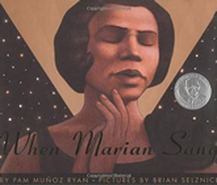
When Marian Sang. Pam Munoz Ryan
Illustrated by Brian Selznick. Scholastic Press, 2002. (2-5)Respect
A splendid picture book biography of Marian Anderson, the early twentieth century African-American singer whose “range of notes caused all the commotion. With one breath she sounded like rain, sprinkling high notes in the morning sun. And with the next she was thunder resounding deep in a dark sky.” This is the story of her gifts and her quest to sing professionally in the face of prejudice in 1920s America. She went overseas, where she became a sensation. Returning to the United States in 1939, Marian was not allowed to sing at (ironically) Constitution Hall, which had a “white performers only” policy. Eleanor Roosevelt intervened, and Marian Anderson sang “My Country ‘tis of Thee” to 75,000 people at the foot of the Lincoln Memorial instead. The lyrics of Marian’s songs (reprinted throughout) underscore her faith and courage in the face of indignity and prejudice.
Illustrated by Brian Selznick. Scholastic Press, 2002. (2-5)Respect
A splendid picture book biography of Marian Anderson, the early twentieth century African-American singer whose “range of notes caused all the commotion. With one breath she sounded like rain, sprinkling high notes in the morning sun. And with the next she was thunder resounding deep in a dark sky.” This is the story of her gifts and her quest to sing professionally in the face of prejudice in 1920s America. She went overseas, where she became a sensation. Returning to the United States in 1939, Marian was not allowed to sing at (ironically) Constitution Hall, which had a “white performers only” policy. Eleanor Roosevelt intervened, and Marian Anderson sang “My Country ‘tis of Thee” to 75,000 people at the foot of the Lincoln Memorial instead. The lyrics of Marian’s songs (reprinted throughout) underscore her faith and courage in the face of indignity and prejudice.
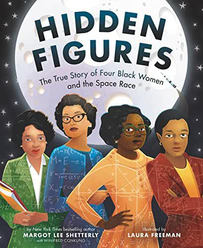
Hidden Figures:The True Story of Four Black Women and the Space Race. Margot Lee Shetterly. Illustrated by Laura Freeman. Harper Collins, 2018. (2-5) Perseverance, Lives to Learn From, Black History.
The inspirational history of Dorothy Vaughan, Mary Jackson, Katherine Johnson, and Christine Darden, all of whom were VERY GOOD at math, and all of whom happened to be African-American. They took jobs at NASA in the 1950s as "computers," (when the term applied to people not machines) and despite prejudice and barriers of the time, were instrumental in the success of the space program. The book's text is workmanlike, not lyrical, but two messages come through loud and clear: men and women of both races put our first men on the moon, and determined and committed individuals who were willing to challenge prejudices of the time, made a difference. A very inspiring collective biography.
The inspirational history of Dorothy Vaughan, Mary Jackson, Katherine Johnson, and Christine Darden, all of whom were VERY GOOD at math, and all of whom happened to be African-American. They took jobs at NASA in the 1950s as "computers," (when the term applied to people not machines) and despite prejudice and barriers of the time, were instrumental in the success of the space program. The book's text is workmanlike, not lyrical, but two messages come through loud and clear: men and women of both races put our first men on the moon, and determined and committed individuals who were willing to challenge prejudices of the time, made a difference. A very inspiring collective biography.

Tiny Stitches. The Life of Medical Pioneer Vivien Thomas.* Gwendolyn Hooks. Illustrated by Colin Bootman. Lee & Low Books, 2016. (2-4) Perseverance, Diligence, Black History Month
Vivien Thomas had dreamed of becoming a doctor since he was young. He saved his money, but in 1929 when the banks collapsed, Vivien had to start saving all over again. He took a job as a research assistant to a surgeon, Dr. Blalock. Thomas was a meticulous researcher. When Dr. Blalock was offered the position of Chief of Surgery at Johns Hopkins Hospital, he insisted that Vivien be his assistant there. Despite many challenges of moving to Baltimore and the racism he confronted, the young researcher did extremely well in his work. A pediatric cardiologist asked for his help in developing a surgery for babies with heart problems. Thomas not only figured out how to do the surgery, but fabricated special, tiny needles for the operations. He continued to work at the medical school his whole career, but it was not until 1971 that Vivien Thomas was publicly acknowledged for his ingenuity and skill. An amazing story of determination and brilliance, illustrated with glowing watercolors.*Available on Epic!
Vivien Thomas had dreamed of becoming a doctor since he was young. He saved his money, but in 1929 when the banks collapsed, Vivien had to start saving all over again. He took a job as a research assistant to a surgeon, Dr. Blalock. Thomas was a meticulous researcher. When Dr. Blalock was offered the position of Chief of Surgery at Johns Hopkins Hospital, he insisted that Vivien be his assistant there. Despite many challenges of moving to Baltimore and the racism he confronted, the young researcher did extremely well in his work. A pediatric cardiologist asked for his help in developing a surgery for babies with heart problems. Thomas not only figured out how to do the surgery, but fabricated special, tiny needles for the operations. He continued to work at the medical school his whole career, but it was not until 1971 that Vivien Thomas was publicly acknowledged for his ingenuity and skill. An amazing story of determination and brilliance, illustrated with glowing watercolors.*Available on Epic!

Schomburg: The Man Who Built a Library Carole Boston Weatherford. Illustrated by Eric Velasquez. Candlewick, 2019. (3-6) Grit, Perseverance, Lives to Learn From, Black History
Afro-Puerto Rican immigrant Arturo Schomburg emigrated to Harlem in the early 1900s, and brought with him a passion for books and a desire to fill a void. Where was the history of people who looked like him? This law clerk and lover of history collected so many works about African history and Black culture that his wife threatened to mutiny. Could he please give them to the library? Or make his own library? Written in free verse, readers will meet the lovable bibliophile who wanted to "tell our stories, proclaim our glories." His collection became the basis for the Schomburg Center for Research in Black Culture and the basis of the New York City Public Library's collection. Rich and full text make this an older children's book.
Afro-Puerto Rican immigrant Arturo Schomburg emigrated to Harlem in the early 1900s, and brought with him a passion for books and a desire to fill a void. Where was the history of people who looked like him? This law clerk and lover of history collected so many works about African history and Black culture that his wife threatened to mutiny. Could he please give them to the library? Or make his own library? Written in free verse, readers will meet the lovable bibliophile who wanted to "tell our stories, proclaim our glories." His collection became the basis for the Schomburg Center for Research in Black Culture and the basis of the New York City Public Library's collection. Rich and full text make this an older children's book.

Booker T. Washington.* Thomas Amper. Illustrated by Jenni Reeves. First Avenue Editions, 1997. (2-4) 48 pages. Justice, Diligence, Black History
This little biography is intended for second to fourth grade children to read themselves, so the language is simple, but the book is well done and provides a fine overview of his extraordinary work ethic from a young age, and his hard-fought rise to prominence as a spokesman for the black community. *Available on Epic!
This little biography is intended for second to fourth grade children to read themselves, so the language is simple, but the book is well done and provides a fine overview of his extraordinary work ethic from a young age, and his hard-fought rise to prominence as a spokesman for the black community. *Available on Epic!

Goin' Someplace Special. Patricia C. McKissack. Illustrated by Jerry Pinkney. (3-5) Justice, Perseverance, Black History Month
This book follows a strong young African-American girl as she navigates a Jim-Crow era Southern town on the way to "Someplace Special" (which we find out at the end of the book is the desegregated public library). Will spark good conversations with older kids about the injustice African-Americans faced under segregation while also depicting perseverance and hope: "Don't let those signs steal yo' happiness." Jerry Pinkney's vibrant illustrations grace another of McKissack's instant classics.
This book follows a strong young African-American girl as she navigates a Jim-Crow era Southern town on the way to "Someplace Special" (which we find out at the end of the book is the desegregated public library). Will spark good conversations with older kids about the injustice African-Americans faced under segregation while also depicting perseverance and hope: "Don't let those signs steal yo' happiness." Jerry Pinkney's vibrant illustrations grace another of McKissack's instant classics.

Frederick's Journey. Doreen Rappaport. Illustrated by London Ladd. Big Words Biography, 2018. (3-6) Justice, Courage
A powerfully illustrated and powerfully told true story. We follow Frederick Douglass from his childhood as a beloved grandson, but an abused slave to several different masters. Douglass's quest for literacy defined his youth, and his refusal to deny or foresake his own human dignity defined his life. He escaped to freedom, then formally bought his freedom, and became publisher of The North Star, an abolitionist newspaper. (Slaves followed the North Star to freedom with underground railroad conductor Harriet Tubman.) His writing, his meetings with Lincoln and advocacy for African-American soldiers in the Civil War are all spotlighted. A moving and well told account of his life-long quest for justice for all, and extraordinary personal courage.
A powerfully illustrated and powerfully told true story. We follow Frederick Douglass from his childhood as a beloved grandson, but an abused slave to several different masters. Douglass's quest for literacy defined his youth, and his refusal to deny or foresake his own human dignity defined his life. He escaped to freedom, then formally bought his freedom, and became publisher of The North Star, an abolitionist newspaper. (Slaves followed the North Star to freedom with underground railroad conductor Harriet Tubman.) His writing, his meetings with Lincoln and advocacy for African-American soldiers in the Civil War are all spotlighted. A moving and well told account of his life-long quest for justice for all, and extraordinary personal courage.
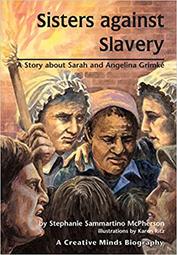
Sisters Against Slavery: A Story about Sarah and Angela Grimke. Stephanie Sammartino McPherson. Lerner Classroom, 1999. (3-6) Courage, Justice
This 64 page biography chronicles the life and work of South Carolina abolitionists Sarah and Angela Grimke. The two daughters of a wealthy plantation owner saw slavery's effects first hand, and were deeply moved by its injustice. The empathetic sisters joined forces to campaign for the slavery's end, which made them very unpopular in their home state. In the 1830s and 40s, they were sought-after speakers and essayists in the north, and reached many audiences. An amazing testament to courage, compassion, and universality of the human spirit.
This 64 page biography chronicles the life and work of South Carolina abolitionists Sarah and Angela Grimke. The two daughters of a wealthy plantation owner saw slavery's effects first hand, and were deeply moved by its injustice. The empathetic sisters joined forces to campaign for the slavery's end, which made them very unpopular in their home state. In the 1830s and 40s, they were sought-after speakers and essayists in the north, and reached many audiences. An amazing testament to courage, compassion, and universality of the human spirit.
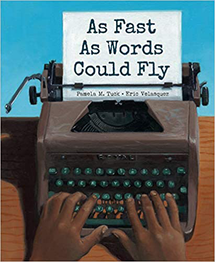
As Fast As Words Could Fly.* Pamela Tuck. Illustrated by Eric Valesquez. Lee & Low Books, 2018. (3-4) Perseverance, Justice, Black History Month
Set in the 1960s, young Mason Steele is happy to help his father turn frustration over civil rights incidents into formal business letters. Pa’s civil rights group is so happy with Mason’s help that they buy him a typewriter. Delighted, Mason teaches himself to type. The civil rights group wins a school desegregation ruling and now Mason can go to the all-white high school. It is hard to not be accepted by the kids and teachers, but Mason tries to do his best. He especially likes typing class. He is chosen to represent the school at a county typing tournament. A story of prejudice met with truth and a crack in racial barriers. Based on a true story of the author’s father. *Available on StorylineOnline.com
Set in the 1960s, young Mason Steele is happy to help his father turn frustration over civil rights incidents into formal business letters. Pa’s civil rights group is so happy with Mason’s help that they buy him a typewriter. Delighted, Mason teaches himself to type. The civil rights group wins a school desegregation ruling and now Mason can go to the all-white high school. It is hard to not be accepted by the kids and teachers, but Mason tries to do his best. He especially likes typing class. He is chosen to represent the school at a county typing tournament. A story of prejudice met with truth and a crack in racial barriers. Based on a true story of the author’s father. *Available on StorylineOnline.com
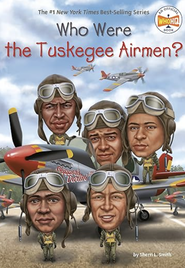
Who Were the Tuskegee Airmen? Sherri L. Smith. Illustrated by Jake Murray. Penguin Workshop, 2018. Black History Month, Love of Country. (3-6)
From the "Who Was" series, this is an in-depth, readable chapter book about the heroic Tuskegee Airmen, African-American fighter pilots who served their country in World War II. With vivid but age-appropriate descriptions of the dangers of World War II, and straightforward discussions of issues like segregation and Jim Crow laws, this book will inspire and inform older elementary school kids. Pen-and-ink illustrations and informative nonfiction sections enrich a gripping historical story.
From the "Who Was" series, this is an in-depth, readable chapter book about the heroic Tuskegee Airmen, African-American fighter pilots who served their country in World War II. With vivid but age-appropriate descriptions of the dangers of World War II, and straightforward discussions of issues like segregation and Jim Crow laws, this book will inspire and inform older elementary school kids. Pen-and-ink illustrations and informative nonfiction sections enrich a gripping historical story.
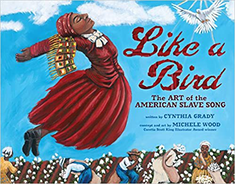
Like a Bird. The Art of the Slave Song.* Cynthia Grady.
Illustrated by Michele Wood. Milbrook Press, 2016. (3-6)
Black History Month, Hope, Faith
Music lends beauty even to our suffering and brings hope. Here the music, lyrics, and history of thirteen Negro Spirituals are compellingly presented and illustrated. Go Down Moses, Swing Low Sweet Chariot, Michael, Row the Boat Ashore, Nobody Knows the Trouble I've Seen are some of the many revisited and explained. Though you may be familiar with some or all of these works sung by slaves in captivity, the explanations of their history and meaning along with the lively folk-art paintings bring new life to this folk art.*Available on Epic!
Illustrated by Michele Wood. Milbrook Press, 2016. (3-6)
Black History Month, Hope, Faith
Music lends beauty even to our suffering and brings hope. Here the music, lyrics, and history of thirteen Negro Spirituals are compellingly presented and illustrated. Go Down Moses, Swing Low Sweet Chariot, Michael, Row the Boat Ashore, Nobody Knows the Trouble I've Seen are some of the many revisited and explained. Though you may be familiar with some or all of these works sung by slaves in captivity, the explanations of their history and meaning along with the lively folk-art paintings bring new life to this folk art.*Available on Epic!
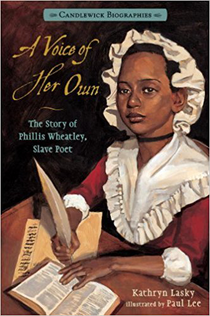
A Voice of Her Own: A Story of Phillis Wheatley, Slave Poet. Kathryn Lasky.
Illustrated by Paul Lee. Candlewick, 2012. (4-6)
Extraordinary story of the enslaved African-American poet, who found a voice of her own even in servitude to the Boston-based Wheatley family. The Wheatley family encouraged her education, and Phillis knew Latin and Greek by the age of twelve. At fourteen, she wrote original verse, and in 1773 became the first published African-American female poet. She was emancipated after the publication of her book, and while the American Revolution with its ideas of equality raged around her. Kathryn Lasky's lyrical prose and Paul Lee's vibrant illustrations bring this improbable story to life.
Illustrated by Paul Lee. Candlewick, 2012. (4-6)
Extraordinary story of the enslaved African-American poet, who found a voice of her own even in servitude to the Boston-based Wheatley family. The Wheatley family encouraged her education, and Phillis knew Latin and Greek by the age of twelve. At fourteen, she wrote original verse, and in 1773 became the first published African-American female poet. She was emancipated after the publication of her book, and while the American Revolution with its ideas of equality raged around her. Kathryn Lasky's lyrical prose and Paul Lee's vibrant illustrations bring this improbable story to life.
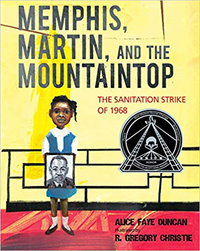
Memphis, Martin and the Mountaintop: The Sanitation Strike of 1968.
Alice Faye Duncan. Illustrated by R. Gregory Christie. Calkins Creek, 2018.
40 pgs. (4-6) Justice, Perseverance, Courage, Black History Month
Compellingly told and vividly illustrated, this is a rich read-aloud for older students. Two black sanitation workers die in Memphis, their tragic deaths linked to unsafe working conditions, and a strike ensues. Told in first person format by the daughter of a sanitation worker, this book gives a clear picture of what it took to ensure justice for the sanitation workers of Memphis. Martin Luther King Jr.'s visit to the city and his support for the striking laborers instills hope. Simple but striking illustrations show the long hours marching, protests, speeches, and the many sacrifices by families of workers (now without pay), who never gave up hope for a just outcome. Finally, after the tragic death of Martin Luther King, Jr, the sixty-five day strike was settled in their favor. Well researched and riveting, this story exemplifies justice, courage, and perseverance.
Alice Faye Duncan. Illustrated by R. Gregory Christie. Calkins Creek, 2018.
40 pgs. (4-6) Justice, Perseverance, Courage, Black History Month
Compellingly told and vividly illustrated, this is a rich read-aloud for older students. Two black sanitation workers die in Memphis, their tragic deaths linked to unsafe working conditions, and a strike ensues. Told in first person format by the daughter of a sanitation worker, this book gives a clear picture of what it took to ensure justice for the sanitation workers of Memphis. Martin Luther King Jr.'s visit to the city and his support for the striking laborers instills hope. Simple but striking illustrations show the long hours marching, protests, speeches, and the many sacrifices by families of workers (now without pay), who never gave up hope for a just outcome. Finally, after the tragic death of Martin Luther King, Jr, the sixty-five day strike was settled in their favor. Well researched and riveting, this story exemplifies justice, courage, and perseverance.
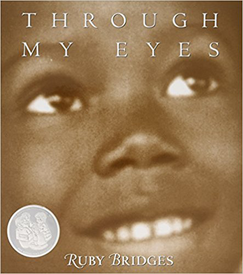
Through My Eyes. Ruby Bridges.
Edited by Margo Lundell. Scholastic Press, 1999.
(4-6)Justice, Compassion
This is a rich, autobiographical look-back on a little girl who didn’t realize she was a heroine. In November 1960 at age six, Ruby Bridges became the first black child to integrate white schools in the South. An adult and lecturer now, Ruby Bridges recounts her story in historical context, and captures the innocence and trust of a child, who did not--until quite far into the conflict--realize that all the fuss was about her skin-color. The book is a testament to her courage and compassion, and our nation’s ongoing quest for racial justice. Sepia-toned photos and excellent sidebars fill out the story. This 63-page book is an outstanding read-aloud for fourth to sixth graders. It is not a young child’s book. (Prefer Robert Coles, The Story of Ruby Bridges for younger grades).
Edited by Margo Lundell. Scholastic Press, 1999.
(4-6)Justice, Compassion
This is a rich, autobiographical look-back on a little girl who didn’t realize she was a heroine. In November 1960 at age six, Ruby Bridges became the first black child to integrate white schools in the South. An adult and lecturer now, Ruby Bridges recounts her story in historical context, and captures the innocence and trust of a child, who did not--until quite far into the conflict--realize that all the fuss was about her skin-color. The book is a testament to her courage and compassion, and our nation’s ongoing quest for racial justice. Sepia-toned photos and excellent sidebars fill out the story. This 63-page book is an outstanding read-aloud for fourth to sixth graders. It is not a young child’s book. (Prefer Robert Coles, The Story of Ruby Bridges for younger grades).
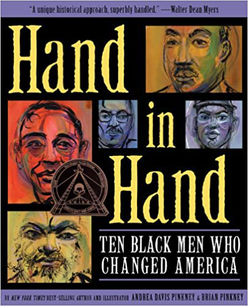
Hand in Hand. Ten Black Men Who Changed America. Andrea Davis Pinkney and Brian Pinkney. Little, Brown Books, 2010. (5-6)
These are ten lively (approximately) twenty-five page biographies of men who were "links in the freedom chain." The Pinkneys bring their signature style to profile Benjamin Banneker, Frederick Douglass, Booker T. Washington, W.E.B. DuBois, A. Philip Randolph, Jackie Robinson, Malcolm X, Martin Luther King, Jr., Thurgood Marshall, and Barack Obama. Any one of the lives might be read over the course of a week in circle time at upper grades. The text sings. For example, on eighteenth century almanac author Benjamin Banneker learning his numbers and studying constellations: "Benjamin was now math-happy and starstruck." On Thurgood Marshall: “He made people feel comfortable by speaking with the ease of a friend but the conviction of a leader.” Read and learn!
These are ten lively (approximately) twenty-five page biographies of men who were "links in the freedom chain." The Pinkneys bring their signature style to profile Benjamin Banneker, Frederick Douglass, Booker T. Washington, W.E.B. DuBois, A. Philip Randolph, Jackie Robinson, Malcolm X, Martin Luther King, Jr., Thurgood Marshall, and Barack Obama. Any one of the lives might be read over the course of a week in circle time at upper grades. The text sings. For example, on eighteenth century almanac author Benjamin Banneker learning his numbers and studying constellations: "Benjamin was now math-happy and starstruck." On Thurgood Marshall: “He made people feel comfortable by speaking with the ease of a friend but the conviction of a leader.” Read and learn!
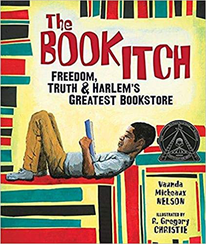
The Book Itch. Freedom, Truth & Harlem’s Greatest Bookstore.* Vaunda Micheaux Nelson. Illustrated by R. Gregory Christie. Carolrhoda Books, 2015. (4-6) Wisdom, Imagination, Perseverance, Black History Month.
The true story of Lewis Michaux, who ignored a banker's advice to sell fried chicken in Harlem, and instead founded "The National Memorial African Bookstore" in the late 1930s. Lewis proclaims "Knowledge is power. You need it every hour. Read a book!" The bookstore specialized in African and African-American history, and became a Harlem landmark. The story is told through the eyes of his son (also Lewis), who relates many of his Dad’s colorful sayings “Books will help him clear the weeds and plant the seeds, so he’ll succeed.” His dad was not a shy man – he wanted to share his love of books with everyone, often pushing a book cart down 7th Avenue to expand his reach. He had a platform in front of the store to host a variety of speakers who led the Civil Rights movement of the ‘60’s. Lewis (the child) meets Muhammad Ali and Malcolm X. The assassination of Malcolm X constitutes a particularly sad and striking part of the book. Vibrant illustration takes us back to that time and place. The subject matter and sorrow make this an older child's picture book. *Available on Epic!
The true story of Lewis Michaux, who ignored a banker's advice to sell fried chicken in Harlem, and instead founded "The National Memorial African Bookstore" in the late 1930s. Lewis proclaims "Knowledge is power. You need it every hour. Read a book!" The bookstore specialized in African and African-American history, and became a Harlem landmark. The story is told through the eyes of his son (also Lewis), who relates many of his Dad’s colorful sayings “Books will help him clear the weeds and plant the seeds, so he’ll succeed.” His dad was not a shy man – he wanted to share his love of books with everyone, often pushing a book cart down 7th Avenue to expand his reach. He had a platform in front of the store to host a variety of speakers who led the Civil Rights movement of the ‘60’s. Lewis (the child) meets Muhammad Ali and Malcolm X. The assassination of Malcolm X constitutes a particularly sad and striking part of the book. Vibrant illustration takes us back to that time and place. The subject matter and sorrow make this an older child's picture book. *Available on Epic!

Vision of Beauty: The Story of Sarah Breedlove Walker. Kathryn Lasky. Illustrated by Nneka Bennett. Candlewick Biographies, 2000. (4-6) Courage, Perseverance, Black History Month.
A realistic biography of Sarah Breedlove Walker (born 1867, first free-born child in her family), who grew up in a poor, sharecropper family but eventually became a successful businesswoman and philanthropist. With two counts against her—black and female—she battled discrimination at every turn in order to start her own business making hair products for black women. The story is gritty and intense—Sarah was orphaned at 7 and married at 14, then widowed by 20—but ultimately a story of clinging to a dream with perseverance. At 56 pages, would be best read over a few Morning Gatherings.
A realistic biography of Sarah Breedlove Walker (born 1867, first free-born child in her family), who grew up in a poor, sharecropper family but eventually became a successful businesswoman and philanthropist. With two counts against her—black and female—she battled discrimination at every turn in order to start her own business making hair products for black women. The story is gritty and intense—Sarah was orphaned at 7 and married at 14, then widowed by 20—but ultimately a story of clinging to a dream with perseverance. At 56 pages, would be best read over a few Morning Gatherings.
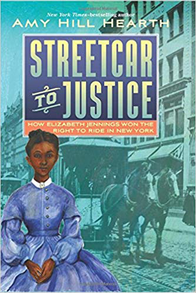
Streetcar To Justice. Amy Hill Hearth.
Greenwillow Books, 2018. (4-6) Justice, Courage, Chapter Book (160 pages)
A compelling historical account of Elizabeth Jennings, who in 1854, was denied a ride on the city streetcar. Elizabeth and her family sue the streetcar company and win not only compensation, but also desegregation for all the streetcars in NYC (nearly 100 years before Rosa Parks). This story is well researched and gives great historical details of what life was like for free blacks in the north at that time.
Greenwillow Books, 2018. (4-6) Justice, Courage, Chapter Book (160 pages)
A compelling historical account of Elizabeth Jennings, who in 1854, was denied a ride on the city streetcar. Elizabeth and her family sue the streetcar company and win not only compensation, but also desegregation for all the streetcars in NYC (nearly 100 years before Rosa Parks). This story is well researched and gives great historical details of what life was like for free blacks in the north at that time.
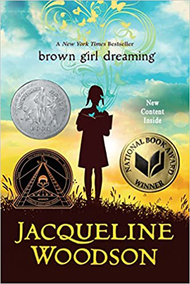
Brown Girl Dreaming. Jacqueline Woodson. Puffin, 2016. 368 pages. (6-8)
Lives to Learn From, Courage, Wonder, Hope, Empathy/Compassion,
A slightly fictionalized memoir, this book is a treasure for adults as well. Written in free verse, it is the poetic memoir of an African-American girl growing up in Ohio, South Carolina, and New York in the 1960s and '70s. Rich and unexpected, this poignant tale recounts a life lived between north and south and poses the question of: what is home? (Woodson's family began life in Ohio, moved to Greenville, SC, then her mother settled the family in Brooklyn, but they returned to South Carolina in summers.) Jacqueline's story is a window into race on a personal level and civil rights struggles as lived by a child. The book's power is one of empathy. From the first page, the reader is inspired by the poetry of Langston Hughes (and then that of Jacqueline Woodson), but this work is not solely about race; it is the story of an open-hearted, searching girl, finding her voice and purpose, and the message is ultimately one of hope. Would-be writers will love it! Because of family situations and historical background, it is a late middle school work.
Lives to Learn From, Courage, Wonder, Hope, Empathy/Compassion,
A slightly fictionalized memoir, this book is a treasure for adults as well. Written in free verse, it is the poetic memoir of an African-American girl growing up in Ohio, South Carolina, and New York in the 1960s and '70s. Rich and unexpected, this poignant tale recounts a life lived between north and south and poses the question of: what is home? (Woodson's family began life in Ohio, moved to Greenville, SC, then her mother settled the family in Brooklyn, but they returned to South Carolina in summers.) Jacqueline's story is a window into race on a personal level and civil rights struggles as lived by a child. The book's power is one of empathy. From the first page, the reader is inspired by the poetry of Langston Hughes (and then that of Jacqueline Woodson), but this work is not solely about race; it is the story of an open-hearted, searching girl, finding her voice and purpose, and the message is ultimately one of hope. Would-be writers will love it! Because of family situations and historical background, it is a late middle school work.
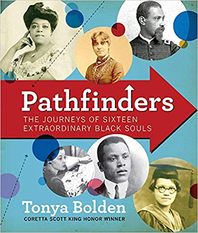
Pathfinders. The Journeys of 16 Extraordinary Black Souls. Tonya Bolden.
Harry N. Abrams, 2017 (5-8) Perseverance, Black History Month. 128 pgs.
“Grit. Guts. Goals.” So begins the stories of sixteen souls you probably haven’t heard of, but are unforgettable once introduced. Mathematician, Banker, Pilot, Race Car Driver, Filmmaker, Cartoonist, Architect: these are fascinating biographies of little known African Americans, accompanied by lots of historical context as well as photographs of the era and people they knew. One of these could be read at morning gatherings over a single or two days.
Harry N. Abrams, 2017 (5-8) Perseverance, Black History Month. 128 pgs.
“Grit. Guts. Goals.” So begins the stories of sixteen souls you probably haven’t heard of, but are unforgettable once introduced. Mathematician, Banker, Pilot, Race Car Driver, Filmmaker, Cartoonist, Architect: these are fascinating biographies of little known African Americans, accompanied by lots of historical context as well as photographs of the era and people they knew. One of these could be read at morning gatherings over a single or two days.

